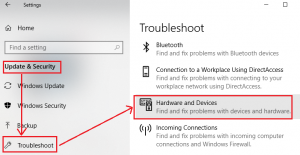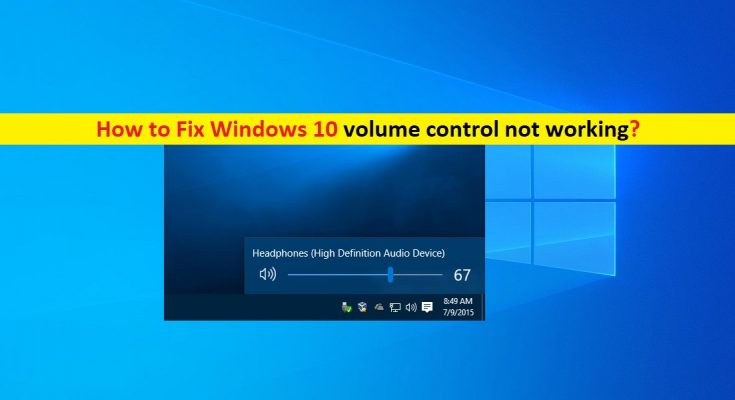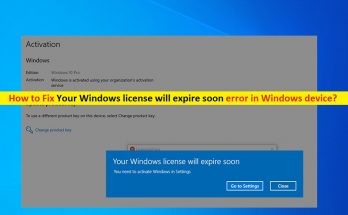What is Windows 10 volume control not working issue?
Here, we are discussing on “How to fix Windows 10 volume control not working issue”. You will be guided with easy steps/methods to resolve this issue. Let’s starts the discussion.
‘Volume control not working’ issue: It is common Windows problem associated with volume/sound issue. This issue indicates that there is some problem in your Windows 10 that could cause ‘volume control not working’ issue. This issue prevents you from accessing Sound/Volume icon on ‘System Tray’ or ‘Taskbar’ on computer for some reasons.
When you try to access Volume/sound icon on ‘Taskbar’ on your Windows 10 computer, and you notice that volume icon is not present in Taskbar or ‘System Tray’, then there is some problem in your Windows computer that’s why you are facing this issue. This issue prevents you from open Volume Mixer, changing volume by clicking Volume icon, and volume controller in your machine.
Some common issue related to ‘Windows 10 volume control not working’ issue:
- Taskbar Volume icon won’t open
- Windows 10 volume slider not working
- Volume mixer won’t open Windows 10
- Volume icon not working
- Keyboard volume control not working Windows 10
- Volume icon not showing in Taskbar
- Taskbar volume icon greyed out Windows 10
The possible reason behind this issue can be outdated or corrupted sound card drivers, problematic Audio services, corruption in system files or registry, corruption in Windows Explorer processes, malware or viruses attack, and other reasons. Also, it might possible your third-party antivirus software is blocking Volume Controller or related services in computer for over security. Let’s go for the solution.
How to fix Windows 10 volume control not working?
Method 1: Fix ‘Volume control not working’ issue with ‘PC Repair Tool’
‘PC Repair Tool’ is easy & quick way to find and fix BSOD errors, DLL errors, EXE errors, problems with programs, malware or viruses issue, system files or registry issues, and other system issues with just few clicks. You can get this tool through button/link below.
Method 2: Update Sound card drivers in Windows 10

Step 1: Open your browser and visit your sound card manufacturer’s official site. Download the latest driver for your sound card according to sound card model and operating system version like Windows 10 64-bit or 32-bit OS.
Step 2: Now, press ‘Windows + X’ keys on keyboard and select ‘Device Manager’
Step 3: Locate and expand ‘Sound, video and game controllers’ category, right-click on your sound card device and select ‘Update Driver’. Follow on-screen instructions to install the downloaded sound card driver.
Step 4: Once done, restart your computer and check if the issue is resolved.
Method 3: Download or reinstall Sound card driver update in Windows 10 [Automatically]
You can also try to update your sound card drivers with ‘Automatic Driver Update Tool’. This software will automatically find the latest updates for all Windows drivers and then install them into your computer. You can get this tool through button/link below.
Method 4: Restart Windows Audio Service
Step 1: Press ‘Windows + R’ keys on keyboard, type ‘services.msc’ in the opened ‘Run’ dialog box and hit ‘Ok’ button to open ‘Services’ window
Step 2: Find and double-click on ‘Windows Audio’ service to open its ‘Properties’
Step 3: Select ‘Automatic’ from ‘Startup type’ dropdown, and click on ‘Stop’ under ‘Service Status’
Section‘, and after few seconds, click on ‘Start’ option under this section
Step 4: Click ‘Ok’ to save the changes and restart your computer, and once done, please check if the issue is resolved.
Method 5: Run SFC Scan
SFC (System File Checker) – Windows 10 built tool offers you to repair system files. This way, you can fix this issue.
Step 1: Press ‘Windows + X’ keys on keyboard and select ‘Command Prompt as Administrator’
Step 2: Type ‘sfc /scannow’ command and hit ‘Enter’ key to execute
Step 3: Wait to complete the process. Once done, reboot your computer and check if the problem is resolved.
Method 6: Run ‘Hardware and Devices’ troubleshooter

You can also try to resolve the issue by running ‘Hardware and Devices’ troubleshooter in your computer.
Step 1: Press ‘Windows + I’ keys on keyboard to open ‘Settings’ App in Windows 10
Step 2: Go to ‘Update & Security > Troubleshoot’, find and select ‘Hardware and Devices’ troubleshooter, and click on ‘Run the troubleshooter’ button
Step 3: Follow on-screen instructions to finish troubleshooting process. Once done, check if the issue is resolved.
Method 7: Make sure Audio Manager is enabled
Step 1: Press ‘CTRL + SHIFT + ESC’ keys on keyboard to open ‘Task Manager’
Step 2: In ‘Task Manager’, click on ‘Startup’ tab, find and right-click on ‘Audio Manager’
Step 3: Select ‘Enable’ option if it is not enabled. Once done, reboot your computer and check if the issue is resolved.
Method 8: Disable SndVol.exe process
Step 1: Open ‘Task Manager’ using above method
Step 2: Find and right-click on ‘SndVol.exe’ process under ‘Processes’ tab, and select ‘End Task’ option
Method 9: Change System font size
Step 1: Open ‘Settings’ App and go to ‘System’ and set ‘Change the size of text, apps and other items’ to any other value
Step 2: Now, sign out your user account of Windows 10 and re-sign into your account and check if the issue is resolved.
Method 10: Disable or uninstall your third-party antivirus software
Sometimes, this issue is occurred due to your third-party antivirus software due to its over security. In such case, you can disable your antivirus temporarily in order to resolve the issue. To do so, right-click on ‘antivirus software’ icon on ‘System Tray’ and select ‘Disable’ or ‘Stop’, or other similar option to disable your antivirus. If disabling antivirus didn’t work, then you can try to fix the issue by uninstalling your antivirus software through ‘Control Panel > Uninstall a Program > Programs & Features’.
Method 11: Restart Windows Explorer process
Step 1: Open ‘Task Manager’, find and right-click on ‘Windows Explorer’ process under ‘Processes’ tab
Step 2: Select ‘Restart’ from menu appear and once done, please check if the error is resolved.
Conclusion
I am sure this article helped you on How to fix Windows 10 volume control not working issue with several easy steps/methods. You can read & follow our instructions to do so. That’s all. For any suggestions or queries, please write on comment box below.



